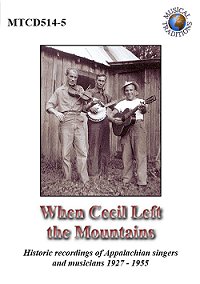
Historic recordings of Appalachian singers and musicians 1927 - 1955
Musical Traditions Records MTCD514-5

I'll dispense with the dispassionate stance of a reviewer and state simply, 'This is great stuff. Go get a copy.' However, perhaps a few details are in order. It has been a century since Cecil Sharp and Maud Karpeles spent fifty-two weeks of three years collecting 1,600 songs and tunes in the Appalachians. You wondered: it comes to about forty pieces per week, about six per day. Remember, there weren't exactly long queues of people waiting to be heard. Finding the informants required exposure to great difficulties of weather, flowing and falling water, weakness, illness, exhaustion, tooth extraction, endless trekking, and indigestible comestibles. The singers had to be named, sought, found, met, befriended, encouraged, and sometimes coaxed to sing. Oft-times the quest came to nothing.
Atypical of those pre-ethnomusicological days, the two collectors were careful to note not only variants of text and tune, but also names, places, and dates. When looking at Sharp's book we see some names often - here's Jane Gentry, there's Reuben Hensley - and there are wonderful names seen less frequently, like Strauder Medford, Meg Shook, and Trotter Gann. When Sharp was later musing over his notes and diaries he had real people in mind, and their places (Buena Vista! Royal Orchard!). What he left behind was his book and, despite having collected all sorts of American songs and tunes, he called it English Folk Songs from the Southern Appalachians. In 1916, there were but two recording devices available, paper and pen. Sharp and Karpeles had the encounters in their ears and in their eyes; we were left very fine, careful notations.
We wouldn't know how the music actually sounded but for happy accident. Less than a decade after Sharp's last trip of discovery, commercial recording companies found gold in the hills and started sending out crews to record the old music, including one singer Sharp met, Dad Blackard (Meadows of Dan). After another decade recording machines became vaguely portable, allowing Alan Lomax to record some of Sharp's informants for the Library of Congress. Shortly thereafter, a radio station recorded some local singers at the White Top Festival. Another decade later, Maud Karpeles, also with Library of Congress support, made the first of two trips to the mountains and recorded people she had, and had not, met thirty years earlier.
Mike Yates, in this brilliant Musical Traditions set, has assembled music from these collections of four decades. The set includes eighty-three songs and tunes from twenty-nine singers and musicians, and forty-four pages of liner notes. There are names here remembered from Sharp's book. It is astonishing to hear the nearly ghostly presence of Dol Small, Linnie Landers, and Eliza Pace. Alas, we can't hear Jane Gentry, but we can listen to her daughter, Maud Long. We can't hear Rosie or Reuben Hensley, but we have their daughters, Emma and Ella. Here are singers that might have been met but weren't. The most famous is the wonderful Horton Barker, and my particular favorite, the haunting Mrs Clyde Sturgill. And the fiddlers! Included are the now well-known Emmet Lundy, Luther Strong, and Bill Stepp, but there are others not previously known to me. Each player made me want to run to my fiddle to see if it could replicate those long-lost sounds.
There are no recording studios here, no dubs. These, with a few exceptions, are people at home, sitting around their tables or porches. Chickens can be heard in the background. There are neighbours chatting. A visitor clears his throat in the middle of a tune. One singer, Mattie Dameron, when asked, expresses disappointment that the old songs aren't being sung, astonishment that people aren't singing at all, and is nearly speechless when Maud Karpeles compliments her singing. Apparently it had never occurred to Mrs Dameron that she brought anything individual or personal to the music. What, these days, is the first thing performers want?
Let me return to those earlier tossed-off words 'forty-four pages of liner notes'. Included are a four-page introduction, nearly two pages of bibliography, six pages of surprisingly detailed biographies of the informants (including information about where else they might be heard), and thirty pages called 'The Songs and Music'. This section contains the names of the musicians, places, dates, words, and lengthy, detailed historical information, tracing one song to, say, 1611, another to a Greek myth, one fiddle tune to an eastern European ancestry. Where necessary for clarification, the essence of a ballad tale is told. Also listed are available recordings of the same song. All of this is remarkably, stunningly detailed work. The single question might be asked concerning whereat all these recordings reside?
Jeff Davis - 4.12.17 - Woodstock, CT
First published in Folk Music Journal, 11, 3 (2018)
with permission of the editor.
| Top | Home Page | MT Records | Articles | Reviews | News | Editorial | Map |